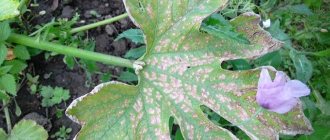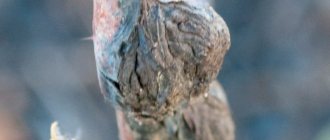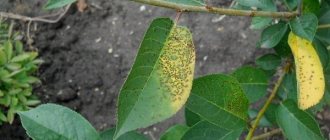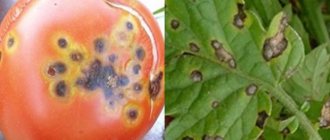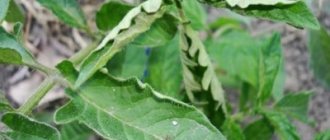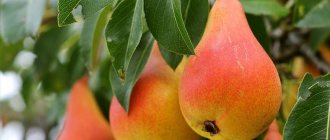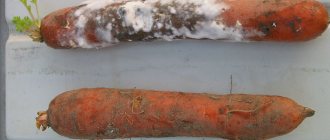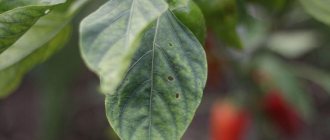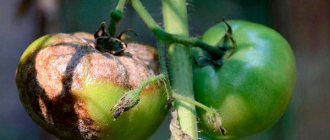Root and stem cancer
Bacterial root canker is a disease common in all climate zones. It is characterized by the formation of tumors approximately 1-3 cm in size with a brown smooth coating on the roots of plants. Later, the tumors grow together and become lumpy, rough, and covered with cracks. When fusion occurs, small tumors tear the cortex.
Cancer slows down the development of plants, they weaken and die in winter. The leaves of diseased raspberries and blackberries turn yellow, the berries lose their visual appeal and good taste. If measures are not taken to combat this disease, it will progress and the plant will eventually die.
Control measures
- For small lesions, diseased plants must be dug up and burned.
- You cannot plant new bushes in place of diseased plants for 2-4 years.
- When cancer spreads massively, it is necessary to change the location of the raspberry and blackberry plants. Healthy planting material should be planted in a new location, having previously treated the ground with a 1% solution of copper sulfate. It should also be used to disinfect the roots of the plant, keeping each seedling in the solution for about 5-10 minutes.
Ring spot
This viral disease is characterized by curling of leaves and the formation of yellow spots on them. The ringspot virus spreads very slowly throughout the garden. But it is dangerous because yellow spots on the leaf blades are visible only in spring and autumn. In summer you may not notice them.
Curled leaves become thin, brittle and easily break from touch or wind. Plants affected by this virus develop poorly and often die.
Control measures
- The virus is spread by nematodes, which can live in the soil and develop on the roots of many other plants, so crop rotation will not help the situation. If more than 20 nematodes are found in 500 g of soil, then the substrate should be treated with nematicides, for example Nematophagin.
- It is not recommended to plant raspberries and blackberries in a place where there used to be beds of strawberries, cabbage or tomatoes. It is best to plant shrubs where beans, peas, broad beans, beans and other legumes grew.
- You should buy seedlings only from official certified nurseries. Plants for propagation must be grown from healthy mother bushes. Plant varieties resistant to the virus.
- Control weeds whose virus-infected seeds may accumulate in the soil.
Useful tips
After harvesting, cut off all stems that show symptoms of anthracnose at the root and burn them.
Dig up the soil around raspberry bushes in early spring and late autumn. At the same time, add phosphorus and potassium fertilizers to the soil.
Unfortunately, folk plant protection products are powerless in the fight against raspberry anthracnose. But it has long been known that the likelihood of this disease is sharply reduced if elderberry, wormwood, tansy, celery, basil, onion, garlic, marigold or calendula are planted near the raspberry tree.
Anthracnose
This fungal disease is most common in warm areas with high humidity. It appears in the form of purple spots on the shoots of raspberries and blackberries. At first the spots are small, then they grow, become purple-gray and spread to the leaves. The bark of the plant gradually turns gray, and the leaves die off. On berries, anthracnose also appears in the form of purple spots, the fruits become dry and tasteless.
Control measures
- All affected shoots must be removed, the soil loosened and treated with fungicides (Agrolekar, Chistoflor, copper oxychloride).
- When planting seedlings, it is important to choose only healthy planting material.
- Plantings should not be allowed to become dense; weeds must be constantly pulled out.
- As a preventive measure, in spring and early summer, raspberry bushes should be sprayed with a 1% solution of Bordeaux mixture or a 0.5% solution of copper oxychloride.
- The drug Prognosis has also proven itself well. 1 ml of the product is dissolved in 1 liter of water and the resulting solution is sprayed on the bushes 3-4 times per season with an interval of 7-10 days.
Raspberry protection
Raspberries in the North-West zone are mainly affected by anthracnose, septoria, rust, spotting, root and stem canker, and viral diseases. Below is a description of these diseases and measures to combat them.
Anthracnose
- a widespread and most harmful disease of raspberries in the North-West zone.
In the Leningrad region, damage to susceptible varieties reaches 80-93%. In diseased plants, the ends of the shoots die, the brushes and berries dry out, and the leaves fall off. Anthracnose (top) and raspberry rust
The causative agent is the fungus Gloeosporium venetum Speg. It affects leaves, shoots, buds, petioles, brushes and berries. Small rounded spots (1-3 mm in diameter) with a gray center and a purple border appear on the leaves. They are located mainly along the veins and along the edges of the leaves. With severe damage, the spots merge, the leaves curl, dry out and fall off. Small depressed spots form on the petioles, resembling sores, which merge and turn into cracks.
Annual and biennial shoots, mainly their ends, are covered with oval, deep gray sores with a purple border. The fabric cracks, becomes corky, turns grey—“gray bark.” The spots ring the fruiting clusters, which dry out as a result. The berries are affected while still unripe, turn brown, become deformed, become one-sided, and dry out. On spots and sores a mass of fungal conidia forms in dark beds. Particularly abundant sporulation is observed in humid weather: conidia protrude from the bed in small light mucous droplets. The fungus overwinters in the form of conidia on affected organs and mycelium in diseased shoots. In spring, fresh spores form on them, which infect the budding leaves. Wet weather promotes the development of anthracnose. In conditions favorable for the fungus, mass formation of conidia occurs all summer, with many repeated generations developing and new plants becoming infected.
No varieties are fully resistant to anthracnose; the least affected are Usanka, Izobilnaya, Herberta, Texas, King, Cuthbert and Turner; Widespread and popular ones are highly susceptible to the disease - Novosti Kuzmina, Kaliningradskaya, Volzhanka, Osennyaya, Progress, English and Seyanets Nemetsa.
Control measures. First of all, it is necessary to grow varieties that are relatively resistant to the disease and carefully select healthy planting material, since stems are the main carriers of anthracnose infection. Before planting, it is recommended to disinfect the offspring in a 1% solution of copper sulfate (100 g per 10 liters of water), followed by rinsing them in water. Severely affected biennial and annual shoots must be cut out entirely, leaving no stumps, and destroyed. If the tops are affected and, moreover, weakly, they are cut off. Fallen leaves and mummified berries are collected and burned. You should avoid dense plantings and placing them in low-lying areas.
Early spring eradicative spraying of dormant buds with a 2.5-3% solution of nitrafen (250-300 g per 10 l of water), 1% solution of DNOC (100 g per 10 l of water) or 4% Bordeaux mixture is mandatory. . In March, you can treat the bushes with a lime-sulfur decoction of strength G (according to Baume). In the summer during the growing season, raspberries are sprayed with 1% Bordeaux mixture, 0.5% captan, 0.5% phthalan or 0.7% zineb.
In small areas, treatment with antibiotics gives positive results: 0.15% griseofulvin (1.5 g per 10 liters of water) or 0.0001% nystatin (100 ml per 10 liters of water).
Timing of spraying: first - when young shoots reach a length of 15-30 cm, second - before flowering, third - immediately after flowering.
Septoria
- a disease that is widespread, especially on wild raspberries, from which cultivated plantings are easily infected. The disease leads to massive drying and falling of leaves, and the appearance of cracks on the stems.
The causative agent is the fungus Septoria rubi Sacc. It affects leaves and stems. The first signs of the disease are observed in June, and it manifests itself throughout the growing season. Round spots form on the leaves, initially brown, later light in the center with black dots of fungal pycnidia on the surface. A mass of pathogen spores develops inside the pycnidia. Partially affected leaf tissue is destroyed, falls out, the spots merge, cover entire leaves and they dry out.
On the stems, the spots are located in the middle part near the buds and internodes. In this case, the tissue cracks, the bark peels off, and the affected areas of the stems are densely dotted with pycnidia.
The fungus overwinters as conidia in pycnidia and as a marsupial stage on affected leaves and stems. The stems are a big source of infection. In spring, overwintered spores infect young leaves and shoots. Moderate temperatures and high humidity promote the development of the disease.
There are no raspberry varieties that are completely resistant to Septorcosis; the least affected are Marlboro, Sovetskaya, Turner, Progress, Vislukha, Kaliningradskaya, Volzhanka and Russkaya; strongly - Novosti Kuzmina, Latham, Usanka, Slava Severa, King, English and Kaluzhanka.
Septoria raspberry
Control measures. To reduce the possibility of plant disease, it is necessary to carefully select healthy planting material from mother plantations and avoid planting highly susceptible varieties as sources of the formation of foci of infection.
Affected leaves should be collected and burned; cut out and destroy weakened and diseased annual and biennial stems, as the fungus persists on them for more than 2 years; Thin out the bushes in a timely manner for better air circulation in the plantings.
Eradication sprays in late autumn or early spring with the same preparations used against anthracnose are mandatory, as well as treatments during the growing season with Bordeaux mixture and its substitutes (copper oxychloride, zineb) in the timing and concentrations recommended for combating anthracnose.
Rust
widespread, causes great harm, reducing yield by 10-30%.
The causative agent is the fungus Phragmidium rubi - idaei Karst. It affects leaves, petioles, stems and shoots. At the same time, in May, yellow-orange small tubercles with spring spores of the fungus appear on the upper side of the leaves, on the petioles, central veins, and young shoots. They quickly infect new leaves and shoots. Later, rusty-brown powdery pustules of summer spores develop on the undersides of the leaves, which cause repeated infections of raspberry plants. By autumn, summer spores on the underside of the leaves are replaced by winter ones in the form of a dark, easily erased coating. On stems, the lesion appears in the root part, it resembles large cankers filled with powdery orange spring spores of the fungus. Diseased stems break and dry out. The mycelium of the fungus penetrates deeply into the rhizome, into the tissues of the stems and remains there for a long time. The pathogen overwinters in the form of winter dark spores on fallen, infected leaves and mycelium in diseased stems. In spring, spores from overwintered infected leaves infect young leaves and shoots.
Increased humidity promotes the development of rust; in dry weather it spreads poorly.
The raspberry varieties Usanka, Sovetskaya, Russkaya, Vechnoplodonosishchaya, Novost Kuzmina, Progress, Zheltaya Spirina and King are less affected by this disease; the most susceptible to it are Latham, Marlborough, Golden Queen and Cuthbert, which on plantations or in nearby areas, even in small numbers, serve as constant reserves of rust pathogen infection.
Control measures. One of the main measures is to use only healthy planting material. Severely affected varieties should not be planted. Bushes infected with stem rust must be uprooted and destroyed. It is necessary to collect fallen leaves, cut out, without leaving stumps, damaged and weakened stems and burn it all, dig up the rows, remove weeds.
In early spring, it is necessary to carry out eradicating spraying with 2-3% nitrafen (200-300 g per 10 l of water) or 1% DNOC (100 g per 10 l of water), while cultivating the soil between the rows.
If rust develops strongly in the summer before flowering, immediately after it and after harvesting, it is necessary to spray the plantings with 1% Bordeaux mixture.
Purple spot
widespread and harmful in the North-West zone. In some places, it affects over 50% of raspberry stems and buds, causing their mass death.
Raspberry purple spot
The causative agent is the fungus Didymella applanata Sacc., which affects all above-ground vegetative organs of raspberries and the root part. Spots appear on the shoots, first light purple, blurry, without a border, later - from purple to red-brown. They quickly increase in size, merge and cover large areas (up to 1/3-1/2) of the shoots. The spots are located below the place where the petiole is attached. Their center gradually becomes lighter and numerous black dots of pycnidia appear in the middle. The buds whose covering scales are affected die off. Large necrotic spots appear on the leaves. Necrosis rings the petioles and fruit branches, causing their death before the berries ripen.
In pycnidia, the fungus produces numerous spores that ripen in July–August. In wet weather, they spread the fungus during the growing season and infect new plants. The fungus overwinters on diseased stems and buds in the form of pycnidia, marsupial stage and mycelium. Purple spot affects raspberries throughout the growing season - from early spring to late autumn. Sometimes, in warm, humid weather, the fungus develops in winter. Then the purple spots increase sharply and ring the stems, which dry out by spring. In spring, overwintered spores infect young leaves and shoots. The development of the disease is greatly enhanced by excessively wet weather, prolonged rains, heavy dew, and damage to raspberries by stem gall midges.
Raspberry varieties that are completely resistant to the disease are unknown; Latam, Novosti Kuzmina, Usanka, Kaliningradskaya, Cuthbert and Herberta are especially susceptible to it.
Control measures. It is necessary to use healthy planting material; good tillage between rows; regular thinning of plantations to ensure better air circulation; carefully cutting out the affected shoots and collecting fallen leaves, and then destroying them.
Early spring eradicative spraying should be carried out with the same preparations that are used against anthracnose, and in the summer, raspberries should be treated according to the scheme recommended for combating anthracnose, using the same chemicals.
To prevent the accumulation of the fungus and the creation of a long-term focus of infection, severely affected varieties must be removed from the site.
Canker spot of stems
- a disease also known as “raspberry stem cancer”. It is common in the North-West zone in places close to wild or feral raspberry thickets, as well as on old perennial plantations. The manifestation and intensity of development of the disease are closely related to the damage to plants by raspberry gall midge.
Canker spotting of raspberry stems
The causative agent is the fungus Coniothyrium wernsdorffiae Laib., which infects stems and has a conidial stage in the form of pycnidia and a marsupial stage in its development cycle. Brown, irregularly shaped spots appear on diseased stems. They grow rapidly along the stem. The center of the spots is first dark, depressed, then gray. The spots rise and dark cracks appear in the recesses. The affected areas take on the appearance of a soaked ulcer, sharper and deeper than with anthracnose. A mass of dark pycnidia covered with spores develops in the cracks. Later, tumors form on the affected areas, which is associated with damage from gall midges. By autumn, numerous glossy black dots of the fruiting bodies of the marsupial stage of the pathogen appear around the spots and cracks in the bark. The surface of the swollen tissues (growths and tumors) is completely covered with fungal spores. The fungus overwinters in the cracks of the stems in the form of pycnidia and the marsupial stage.
Full maturation of pycnidia occurs in late May - early June. From this time and throughout the entire raspberry growing season, the fungus infects plants, especially in the presence of mechanical damage, cracks, and gall midge settlements.
The disease is transmitted by planting material. Permanent foci of infection are created on plantations with permanent raspberry cultivation, accompanied by poor agricultural practices, or in abandoned and wild thickets. The development of the disease increases with high humidity and warm weather.
Varieties resistant to the disease are unknown.
Control measures. It is mandatory to plant only healthy offspring. It is necessary to carefully inspect the bushes, cut out and destroy stems affected by canker spot and raspberry stem gall midge.
In early spring, it is necessary to carry out eradicating spraying with 1% DNOC or drugs recommended against anthracnose, and during the growing season, if there is a strong development of the disease, with a 0.7% solution of 50% zineb.
Autumn spot
appears in mid-summer and is widespread in places where raspberries are cultivated or where there are wild raspberry thickets.
Autumn raspberry spot
The causative agent is the fungus Cylindrosporium rubi Ell. et Morg. - affects leaves of all ages, causing them to fall prematurely. Symptoms of the disease are especially typical in wet weather on adult leaves, on which large (3-6 mm), angular, brown, rapidly enlarging spots are formed, bounded by veins. They do not lighten, do not fall out, and do not have a border. On the surface of the spots there are numerous conidial beds of the fungus covered with the epidermis. With increased air humidity, the epidermis of the leaf ruptures and a light mass of spores appears from under it.
The first signs of the disease in the North-West zone are detected at the end of June - July. The maximum of its development occurs in August, when fruit buds are laid on raspberries. Premature loss of viable leaves results in reduced yield the following year. In the development cycle of the fungus, in addition to the conidnal stage, there is a marsupial stage. Conidia are produced throughout the summer, infecting and re-infecting surrounding bushes. Spores spread especially quickly with raindrops. The fungus overwinters on fallen, infected leaves. In spring, spores ripen on them again and infect young leaves.
The resistance of varieties to the disease has not yet been studied.
Control measures. The area occupied by raspberries must be thoroughly cleared of fallen leaves and destroyed or buried in compost pits.
Early spring eradicative spraying should be carried out with a 3% solution of nitrafen (300 g per 10 l of water) or a 4% solution of copper sulfate (400 g per 10 l of water). During the growing season, raspberries need to be treated in the same way as against other spots - anthracnose, septoria.
Root bacterial cancer
(root goiter) is a long-standing, widely known disease of raspberries. It is distributed in the Northwestern, Central, and Southeastern zones of the country, and is found in Siberia, Kazakhstan, and the Far East.
Up to 50-60% of raspberry plants are affected by root cancer in the foci of the disease, more often when it is cultivated for a long time in one place. The harmfulness of the disease is especially strong because raspberries very poorly tolerate insufficient root activity. Plants are sharply weakened, the root growth of diseased bushes is half that of healthy bushes, the shoots are thin, the leaves are yellow, the berries are small and dry. Yield, frost resistance and drought resistance are sharply reduced. Complete plant death is not observed due to abundant shoot formation in raspberries. Often, due to root canker (especially in areas where the infection is widespread), raspberry cultivation becomes impossible.
The causative agent is the bacterium Pseudomonas tumefaciens Stev. The pathogen is polyphagous, easily infects many plants from various families, especially apple trees, young fruit trees in nurseries, gooseberries and currants.
The disease affects rhizomes, the base of shoots of root shoots, and roots. The pathogen penetrates the root system mainly through wounds caused by soil cultivation or by insects. Tumors ranging in size from a pea to nodules with a diameter of 3-5 cm or more develop on diseased organs. The surface of the tumors is brown, smooth, later lumpy, rough, with cracks. The fabric inside is light and hard. After 1-2 years, the tumors disintegrate, infecting the soil, where the viability of the pathogen persists for up to 2-3 years. Then the bacteria die under the influence of antagonist microbes. The alkaline reaction of the soil is favorable for the pathogen, and the acidic reaction inhibits its development.
The disease spreads through the soil and also through flood waters. The infection is introduced to new areas with water, soil and planting material when subtle, small tumors are not removed from the offspring.
There are no raspberry varieties immune to the disease; extremely susceptible to it - Marlborough, Cornish, Victoria and Kaliningrad; strongly affected - Vislukha, Progress, Novosti Kuzmina and Usanka; less - Yellow Spirina.
Control measures. It is necessary to carefully examine the root system of planting material, select healthy plants, and use less susceptible varieties. Small nodules should be removed, the roots of all plants should be disinfected by immersion for 5-10 minutes. in a 1% solution of copper sulfate, and then rinse in clean water. Raspberries should not be placed in areas flooded by floods; it is not advisable to cultivate them after such predecessors as fruit nurseries and apple orchards. In areas where foci of cancer are found, raspberries should not be planted for 2-3 years. To improve the soil health, it is recommended to sow legumes and grain crops and suppress the activity of the cancer pathogen by introducing manure, which activates the antagonistic flora.
Stem bacterial cancer
- a disease found in the North-West zone, in the south-east of the country, in Siberia. It is characterized by high harmfulness. With stem canker, the development of fruiting shoots is inhibited, few berries are produced, and even those that are small and sour, the shoots often dry out and completely die, and the quality of planting material sharply decreases.
Raspberry stem bacterial canker
The causative agent is the bacterium Pseiidomonas rubi Hild. causes systemic bacteriosis, affecting fruiting and annual shoots, buds, fruit branches, leaves, pedicels and flowers. Comb-shaped tumors elongated along their length appear on the stems, consisting of small granular swellings that gradually merge and rupture the integumentary tissue. The tumors reach a length of 10-20 cm, located along the vessels, and sometimes ringing of the stem is observed. At first, the tumors are soft and white, then they become brown, hard, dry out and collapse. The lower and middle parts of the stem are most often affected. Diseased kidneys increase sharply and die.
The pathogen overwinters inside the affected tissues and in the vessels of diseased plants. The disease appears throughout the growing season; the optimal temperature for its development is 25-26°. The infection spreads through air currents, moisture, and planting material.
Bacteria enter the plant through mechanical damage. The pathogen persists in the soil. The harmfulness of the disease increases with high humidity, variable temperatures, and in winters with frequent thaws. Varieties immune to the disease are not yet known. Control measures. Before planting, it is necessary to carefully examine the offspring and discard those with signs of disease; on a plantation - cut out diseased shoots and uproot heavily affected bushes, then immediately and be sure to burn them. It is prohibited to select planting material in places where there are foci of disease.
As surveys have shown, in the Leningrad region, from viral diseases
Raspberries are most common mosaic. They are also found everywhere on wild raspberries. Their main feature is a change in the color and sometimes shape of the leaves. The color of the leaves is varied and varies depending on the raspberry variety, time of infection and weather conditions.
These diseases are more often observed in collective gardens and personal plots.
In a number of cases, growth (dwarfism) of raspberries has been observed in the North-Western zone.
Leaf spotting (yellow mosaic).
When the disease occurs, the leaves acquire a variegated color, becoming covered with yellow-green, light green or yellow spots scattered over the entire surface. The size of the spots varies - they often look like very small light green speckled dots. In this case, the mottling is most pronounced on the lower tiers of leaves; The first signs of mosaic usually appear on young leaves.
Yellow raspberry mosaic (top) and blackcurrant powdery mildew
Vein mosaic
- a disease whose typical signs are the brightening of the veins and the appearance of light-colored spots along them. Symptoms of the disease usually appear in spring and autumn. In the summer, especially in hot weather, the abnormal coloring of the leaves temporarily disappears. Sometimes individual sections of the leaf blade become more convex and the leaves become wrinkled.
In individual plots and in collective gardens, plants infected with viruses and signs of leaf curl are also found. In this case, the edges of the leaves bend down, their surface wrinkles, and the affected shoots are shortened. The disease manifests itself most sharply on shoots of the second year. The number of replacement shoots is significantly reduced.
With mosaic diseases, raspberry yields drop by 25-50%, young shoots lag behind in growth, and the winter hardiness of the affected bushes decreases.
Very often, the cause of raspberry mosaic is a complex viral infection, i.e. the simultaneous development of several different viruses in the plant, as a result of which the degree of susceptibility and, consequently, the harmfulness of the disease increases.
Various types of mosaics are transmitted with planting material, and infected bushes are a source of infection throughout all years of their growth, and the severity of the disease increases every year.
During the raspberry growing season, mosaic pathogens are transmitted to healthy plantings by leaf (Amphorophora rubi Kalt.) and raspberry (Aphisidaei L.) aphids, which are common in the Northwestern zone.
Leaf aphids are quite large (3-4 mm long), greenish-white. In summer, aphids are found on the lower surface of leaves (first on the lower tiers), and then move to the ends of young shoots, where they accumulate in large quantities. Aphids overwinter on raspberry shoots at their base in the egg stage.
Raspberry aphids are small. It overwinters in the upper part of annual raspberry shoots in the axils of newly formed buds. In spring, aphids develop on the tips of shoots and leaf petioles, and in summer - on the underside of leaves.
Viruses are spread from diseased plants to healthy ones mainly by winged aphids, which feed mainly on young shoots of the current year's growth. Therefore, chemical treatments should be carried out as early as possible in the growing season.
The raspberry varieties Kostinbrodskaya and Rubin are relatively resistant to mosaic; Novost Kuzmina, Kaliningradskaya and Latam are severely affected.
Overgrowth (dwarfism)
- a disease in which raspberry plants produce a large number of weak, thin, discolored shoots, additional branches appear on fruiting shoots, internodes are shortened, several shoots can develop from one node, as a result of which their total number sometimes reaches 200-300 per bush, and plantings become denser and take on a dwarf appearance.
Viral growth of raspberries
The leaves of diseased plants are crushed and painted a lighter color than those of healthy ones. In some varieties of raspberries (News Kuzmina, Kaliningradskaya), the sepals and petals turn into leaf-like formations or grow in the form of an abnormal raceme with sterile flowers. The number of fruit clusters is significantly reduced, and the yield is sharply reduced. With severe damage, the plants do not bear fruit at all. The process of bush growth is long, sometimes in this state the plant can live for 10-15 years.
The virus that causes raspberry growth does not infect healthy plants upon contact with diseased branches and leaves, and does not spread through equipment and soil.
The main source of infection persistence is planting material. On plantations, infection of healthy raspberry plants from sick ones occurs through leafhoppers (Macropsis fuscula Zett.), which, according to literature data, are carriers of the growth virus abroad and in the USSR (middle zone of the Non-Chernozem Zone). Characteristic signs of raspberry disease after infection with a virus through leafhoppers appear after 1-2 years.
Leafhoppers Macropsis fuscula Zett. have a length of 5-6 mm (females). They are dark yellow, with transparent wings, light, darker-colored legs at the base, with a characteristic pattern of black spots on the head.
Cicadas overwinter in the egg stage inside the stem tissues near the lateral buds of cultivated and wild raspberries. Only adult insects can become infected with the virus and transfer it to healthy plants.
The Latham raspberry variety is resistant to growth; severely affected - Kaliningradskaya, Novosti Kuzmina and most foreign varieties (Norfolk, Redbod, Lloyd George, etc.).
Control measures. The main measure to prevent raspberries from being damaged by viral diseases is the use of healthy planting material. This requires the establishment of special nurseries, which should produce raspberry planting material that is free from viruses.
When establishing nurseries, great attention should be paid to selecting offspring from apparently healthy plants to create mother plantings. Previously, twice during the growing season - during the period of leaf growth and at the end of summer after the subsidence of high temperatures - nurseries and uterine plantations should be examined for raspberry mosaic infestation. However, studies by many foreign and Soviet scientists have shown that selection and cleaning based only on external signs of disease is not enough to obtain healthy planting material.
Currently, the most effective measure for the recovery of raspberries from viruses (especially varieties that are severely affected by mosaic) is heat treatment. Moreover, starting in April for 3 months, plants are grown in thermal chambers at a temperature of 38°. During this time, they are disinfected from viruses that cause various types of mosaics. Raspberry varieties Novost Kuzmina and Kaliningradskaya tolerate elevated temperatures quite satisfactorily.
The healthy plants obtained in this way are the initial super-elite material for further propagation. In nurseries, they should be planted in an area strictly isolated (at a distance of at least 1000-1500 m) from mother, industrial and individual plantings. Mother plantations, in turn, must have spatial isolation from commercial plantings. Every year, it is necessary to conduct thorough examinations in nurseries and mother plantations, remove plants that have external signs of the disease, and fight aphids that carry mosaic.
To establish industrial raspberry plantations, you need to use planting material obtained only from healthy mother plants. On personal plots and in collective gardens, it is impossible to plant random planting material, especially with mosaic variegated leaf colors, since in these conditions, where simultaneous chemical treatments are practically impossible throughout the entire tract, the likelihood of an increase in viral diseases is very high.
On industrial plantations and plots of amateur gardeners, it is mandatory to examine raspberries for viral diseases at the same time as when planting nurseries, remove diseased plants and burn them.
Chemical control of aphids is a preventive method that prevents the spread of viruses that cause mosaic disease during the raspberry growing season. Treatment against aphids should be carried out twice: the first - during the period of bud break and the appearance of leaves (at this time aphid larvae hatch from the eggs) and the second - after 2-3 weeks (before raspberry flowering), but no later than 30 days before harvesting harvest.
For spraying you can use: 0.2% solution (20 g per 10 l of water) of 40% nicotine sulfate, 0.2-0.3% solution (20-30 g per 10 l of water) 30 % karbofos emulsion concentrate, 0.2-0.3% solution (20-30 g per 10 l of water) of 35% emulsion concentrate or 30% wettable fozalone powder.
In personal plots and in collective gardens, in addition to treatment with karbofos and fozalon, it is recommended to pollinate raspberries with pyrethrum (1 part powder * + 2 parts road dust, dose - 100-250 g per 100 m2) or spraying 1% (100 g per 10 l of water ) suspension of the drug with the addition of soap.
Amateur gardeners are also recommended to use infusions and decoctions of plants to combat aphids, which have a detrimental effect on insects. Here are a few recipes:
1) leave 400 g of tobacco dust (production waste) in 10 liters of water for 24 hours, boil for 2 hours and strain the broth. Before spraying, dilute the broth with water in a 1:1 ratio and add 20 g of soap for every 10 liters of liquid;
2) leave 1.2 kg of green or 0.6-0.8 kg of dry potato tops in 10 liters of water for 3-4 hours and treat the plants with the freshly prepared strained solution in the evening;
3) chop 800 g of well-dried yarrow plants collected at the beginning of flowering and steam for 30-40 minutes. in boiling water, add water to a volume of 10 liters and leave for 36-48 hours. To prepare decoctions, the components are taken in the same ratio. Boil dry plants soaked in water for 30 minutes. and strain the broth. Add 20 g of soap to 10 liters of infusion or decoction.
4) infuse 1 kg of dried chamomile (leaves and baskets - inflorescences collected during its flowering) in 10 liters of water for 12 hours, strain and before spraying, add triple the amount of water and 40 g of soap to the infusion.
Overgrowth (dwarfism) of raspberries, as indicated, is transmitted with planting material. Therefore, the system of preventive measures aimed against this disease has much in common with measures to combat mosaic. The virus that causes the growth is easily destroyed by elevated temperatures. Keeping sick offspring in water at a temperature of 45° for 2 hours. disinfects them from the virus. Under regimes that free raspberries from the mosaic, disinfection also occurs from growth.
Inspection of plantings to identify the disease by its external signs must be carried out several times during the growing season: first - during the period of bud break, while the presence of the disease and the degree of its development are determined by the number and size of last year's shoots or offspring; second - during the flowering period, since in some varieties the presence of the disease is detected by altered flowers; the third - at the end of the growing season, when diseased bushes are finally identified by the resulting offspring. Plants with symptoms of growth are dug up and burned, and all roots must be carefully selected.
On industrial plantations, the spread of growth in the summer is sharply limited by chemical treatments against the vector - leafhoppers. It is recommended to spray commercial plantings on farms twice: the first time before the raspberries bloom, the second time 2-3 weeks after the first. In addition, in nurseries and in breeding areas, a third treatment is carried out during the flight of adult leafhoppers with a 0.2-0.3% solution (20-30 g per 10 l of water) of karbofos or a 0.2% solution (20 g per 10 liters of water) fozalone.
Septoria or white spot
Septoria blight appears as round, first brown and then whitish spots bordered with a purple outline on the leaves and stems of raspberries and blackberries. Vague spots with black dots usually form in the middle of the stem, damaging the shoot covering. Affected shoots, buds and leaves die, bushes weaken and lose their ability to produce crops.
Control measures
- A large amount of nitrogen fertilizers can contribute to the spread of the disease, so you need to feed the plants according to the norms.
- Affected shoots and leaves must be immediately cut out and burned.
- Before the buds open, you need to spray raspberries and blackberries with Bordeaux mixture or a 0.5% solution of copper oxychloride.
- For prevention, bushes need to be treated 3-5 times per season (with an interval of 7-10 days) with Fitosporin-M: 5 g of powder is dissolved in 10 liters of water. The drugs Agrolekar, Forecast or Chistoflor are also used.
Description of the disease
Anthracnose on raspberries is manifested by the formation of small brown spots with a thin purple border on the leaves or stems of annual shoots. If treatment is not started immediately, they will begin to increase in size and merge with each other. Then the leaf dries up and falls off. To better imagine the visual manifestations of the disease with the slightest nuances, look at the photographs when reading its description.
Simultaneously with the appearance of spots on the tops of annual stems, gray, rounded sores form. These foci of inflammation along the contour have a reddish tint. On the affected stems, the bark becomes brown, pockets of inflammation appear on it in the form of scabs, and their thickness can be impressive.
Things are worse with two-year-old stems. If annual shoots do not die when ulcers appear, then those that are 2 years old always die off. Before this, the berries on such stems acquire a brown color, as in the photo, and lose their juiciness and aroma.
Mosaic
Mosaic is a viral disease in which the leaves of a plant lose their natural, uniform, rich color, become deformed and become smaller. As a rule, the leaf of a diseased shrub is dark in the middle and light at the edges. The disease manifests itself especially clearly at the beginning of summer. The mosaic leads to the degeneration of raspberries and blackberries: thin and weak bushes produce very few hard and tasteless berries.
Control measures
- Like other viral diseases, mosaic cannot be cured, so infected bushes should be uprooted and burned.
- Since the virus is transmitted by aphids, mites and with infected planting material, it is necessary to plant healthy seedlings, promptly treat plants against sucking insects, and also do not forget about prevention. Shrubs should be treated with Pentafag (200 ml of the drug per 10 liters of water) every 8-12 days.
Rust
Rust is a fungal disease. It is distributed everywhere and is most active in conditions of high humidity. Rust can be diagnosed by the presence of yellowish-brown bumps on the front side of raspberry and blackberry leaves in spring and early summer.
On the shoots, the disease manifests itself in the form of grayish sores with a reddish outline. By autumn, a dark coating appears on the back of the leaves - these are fungal spores preparing for the winter. Rust leads to reduced yields and plant death.
Control measures
- Affected shoots and leaves must be removed and burned. And the soil should be loosened regularly.
- Plantings should not be allowed to become dense and bushes should not be overgrown with weeds.
- In spring, it is recommended to mulch the soil under the bushes with manure or compost.
- Affected bushes should be treated with Bordeaux mixture or other preparations - Fitosporin-M, Profi, Topaz (according to the instructions).
Purple spotting, or didymellosis
This insidious disease primarily affects young (annual) shoots, petioles and buds. Brown or reddish-purple blurry spots appear on them. Over time, they grow, darken and ring the shoot. The bark cracks and peels, and soon dark brown spots form on the leaves.
Control measures
- Absolutely all affected shoots must be cut out.
- If signs of disease are detected, plants should be treated according to the following scheme:
| Drug, remedy | Dosage | Frequency of treatments |
| Fitolavin Agromedicine | 20 ml per 10 liters of water 7-10 ml per 10 liters of water | Twice per season with an interval of 3-4 weeks |
| Biocomplex BTU+ Liposam adhesive | 80 ml per adult bush 1 ml per 1 liter of water | Twice per season with an interval of 3-4 weeks |
| Bordeaux mixture-F | 1% solution | Once in the spring |
| Farmayod | 3% solution | Once in the fall |
Control measures
Any fungicide is used against gray rot of raspberries and blackberries, and it is best to alternate the drugs, because the causative agent of the disease quickly develops resistance to a particular fungicide. Currently, many gardeners prefer to use biological preparations - Fitosporin-M (5 g of powder is dissolved in 10 liters of water and the bushes are sprayed 3-5 times per season with an interval of 7-10 days), Sporobacterin (20 g of the drug is diluted in 10 liters of water and spraying is carried out during the budding phase and after harvesting) or Alirin-B (5-10 tablets are dissolved in 10 liters of water, the bushes are sprayed during the budding phase, immediately after flowering and at the beginning of berry formation every 7-10 days).
If you are a supporter of more radical chemicals, treat the raspberries with Topaz, Chistoflor, Profi, being sure to follow the recommended time limits before picking the berries.
- Gray mold - signs of the disease and ways to combat it
How to understand that your plants are sick with gray rot and what can be done in this situation?
Curly
This viral disease most often manifests itself on the shoots of the second year: the leaves curl, turn bronze on the reverse side, and their veins become glassy. The flowers also become deformed: their calyx grows. The fruits do not set, the plants are stunted, the bushes are thinning.
Control measures
- The virus can be carried by aphids, so pests need to be dealt with in a timely manner: treat the bushes with a solution of Abiga-Pik, Skor, Fufanon-Nova.
- If signs of disease are detected, the plant must be uprooted immediately before the virus spreads to healthy specimens.
- To prevent the disease, one of the treatment schemes is used:
| A drug | Dose | Frequency of treatments |
| Pentafage | 200 ml per 10 liters of water | 3-5 times with an interval of 7-10 days |
| Farmayod | 1,5% | 2-3 times with an interval of 14 days |
Systemic contact fungicides
In recent years, a number of drugs have appeared that have both systemic and contact effects on fungal spores. In addition, these preparations contain substances that are beneficial for plants and soil. For this reason they are in demand.
To treat raspberry trees, gardeners recommend using aqueous solutions of the following preparations:
However, it is worth warning that the drug “Fundazol” can only be used if the raspberry tree is severely affected by anthracnose. It can be used once a year, not more often.
Overgrowth, or dwarfism
This disease is popularly called “witch’s broom”. The disease is caused by single-celled microorganisms (mycoplasmas). Instead of strong shoots, numerous thin and stunted shoots appear on the plant. The leaf petioles lengthen, the flowers change and do not set fruit. The disease can be carried by aphids and leafhoppers.
Control measures
- Shrubs should be inspected annually and specimens with signs of mycoplasma disease should be destroyed.
- To combat vectors of infection during the growing season, chemical treatments should be carried out in a timely manner. Raspberries and blackberries are sprayed before flowering (during the period of bud release) and after harvesting with 1.5% Farmayod.
- In areas where the dwarf virus has been identified, it is not advisable to grow varieties susceptible to the disease: Novost Kuzmina, Kaliningradskaya, Progress, Vislukha, Glen Klova, Barnaulskaya, Usanka, Carnival. It is necessary to give preference to varieties resistant to growth, such as Latham, Newburgh, Phoenix, Zolotaya Koroleva, Alma-Ata.
If your raspberries and blackberries are sick, it is important to quickly and correctly determine the cause of the disease in order to deal with it as soon as possible. Fortunately, now you know what the symptoms of a particular disease are.
Types of diseases, causes of occurrence
Of course, the best thing is to prevent raspberry diseases from attacking the berry garden by taking timely precautions. But even with careful care, there is a risk of infection, since the culture is quite susceptible to them. Therefore, it is important to know what to do in such situations.
Types of raspberry diseases:
- fungal;
- caused by bacteria;
- viral.
Some pathogens are spread by insects (aphids, leafhoppers, mites), so the fight against them must be comprehensive, with treatments against pathogens and garden pests.
Causes of infections:
- violations in care (droughts, excessive waterlogging, excess fertilizer);
- thickened plantings;
- infected seedlings;
- lack of crop rotation on the site (contaminated soils);
- unfavorable weather conditions.
For treatment, fungicides are used, treatments are carried out with pesticides (for insect pests), and folk remedies. The latter are effective as a preventive measure in the initial phases of infection. If the disease is detected late, then “chemistry” will have to be used.
